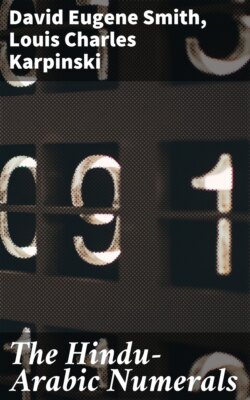Читать книгу The Hindu-Arabic Numerals - Louis Charles Karpinski - Страница 8
ОглавлениеIn the so-called Śaka inscriptions, possibly of the first century B.C., more numerals are found, and in more highly developed form, the right-to-left system appearing, together with evidences of three different scales of counting—four, ten, and twenty. The numerals of this period are as follows:
There are several noteworthy points to be observed in studying this system. In the first place, it is probably not as early as that shown in the Nānā Ghāt forms hereafter given, although the inscriptions themselves at Nānā Ghāt are later than those of the Aśoka period. The four is to this system what the X was to the Roman, probably a canceling of three marks as a workman does to-day for five, or a laying of one stick across three others. The ten has never been satisfactorily explained. It is similar to the A of the Kharoṣṭhī alphabet, but we have no knowledge as to why it was chosen. The twenty is evidently a ligature of two tens, and this in turn suggested a kind of radix, so that ninety was probably written in a way reminding one of the quatre-vingt-dix of the French. The hundred is unexplained, although it resembles the letter ta or tra of the Brāhmī alphabet with 1 before (to the right of) it. The two hundred is only a variant of the symbol for hundred, with two vertical marks.[70]
This system has many points of similarity with the Nabatean numerals[71] in use in the first centuries of the Christian era. The cross is here used for four, and the Kharoṣṭhī form is employed for twenty. In addition to this there is a trace of an analogous use of a scale of twenty. While the symbol for 100 is quite different, the method of forming the other hundreds is the same. The correspondence seems to be too marked to be wholly accidental.
It is not in the Kharoṣṭhī numerals, therefore, that we can hope to find the origin of those used by us, and we turn to the second of the Indian types, the Brāhmī characters. The alphabet attributed to Brahmā is the oldest of the several known in India, and was used from the earliest historic times. There are various theories of its origin, none of which has as yet any wide acceptance,[72] although the problem offers hope of solution in due time. The numerals are not as old as the alphabet, or at least they have not as yet been found in inscriptions earlier than those in which the edicts of Aśoka appear, some of these having been incised in Brāhmī as well as Kharoṣṭhī. As already stated, the older writers probably wrote the numbers in words, as seems to have been the case in the earliest Pali writings of Ceylon.[73]
The following numerals are, as far as known, the only ones to appear in the Aśoka edicts:[74]
These fragments from the third century B.C., crude and unsatisfactory as they are, are the undoubted early forms from which our present system developed. They next appear in the second century B.C. in some inscriptions in the cave on the top of the Nānā Ghāt hill, about seventy-five miles from Poona in central India. These inscriptions may be memorials of the early Andhra dynasty of southern India, but their chief interest lies in the numerals which they contain.
The cave was made as a resting-place for travelers ascending the hill, which lies on the road from Kalyāna to Junar. It seems to have been cut out by a descendant of King Śātavāhana,[75] for inside the wall opposite the entrance are representations of the members of his family, much defaced, but with the names still legible. It would seem that the excavation was made by order of a king named Vedisiri, and "the inscription contains a list of gifts made on the occasion of the performance of several yagnas or religious sacrifices," and numerals are to be seen in no less than thirty places.[76]
There is considerable dispute as to what numerals are really found in these inscriptions, owing to the difficulty of deciphering them; but the following, which have been copied from a rubbing, are probably number forms:[77]
The inscription itself, so important as containing the earliest considerable Hindu numeral system connected with our own, is of sufficient interest to warrant reproducing part of it in facsimile, as is done on page 24.
The next very noteworthy evidence of the numerals, and this quite complete as will be seen, is found in certain other cave inscriptions dating back to the first or second century A.D. In these, the Nasik[78] cave inscriptions, the forms are as follows:
From this time on, until the decimal system finally adopted the first nine characters and replaced the rest of the Brāhmī notation by adding the zero, the progress of these forms is well marked. It is therefore well to present synoptically the best-known specimens that have come down to us, and this is done in the table on page 25.[79]
